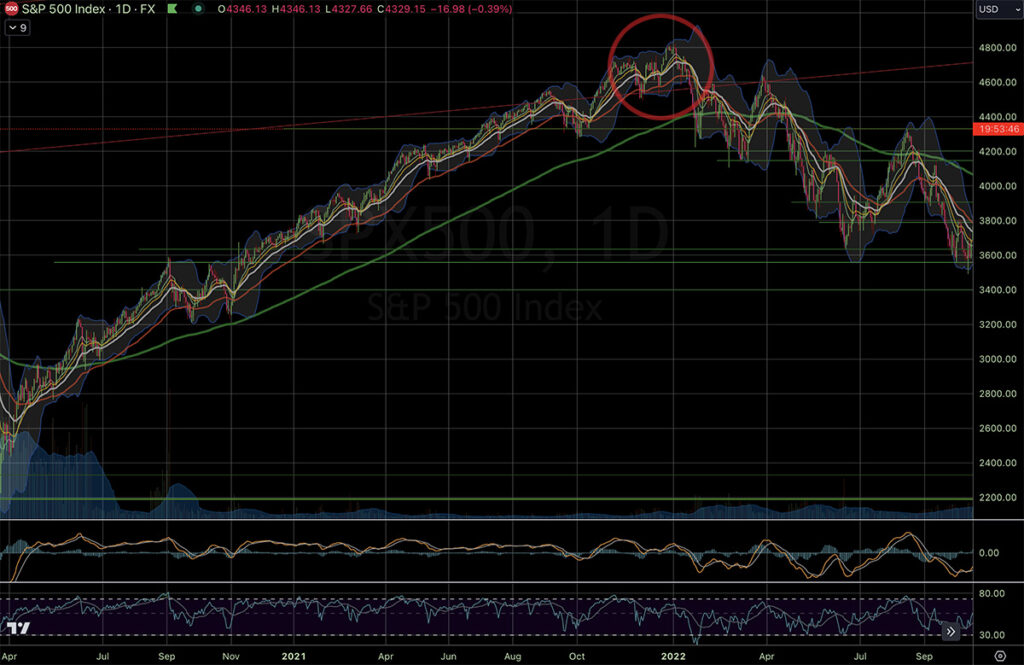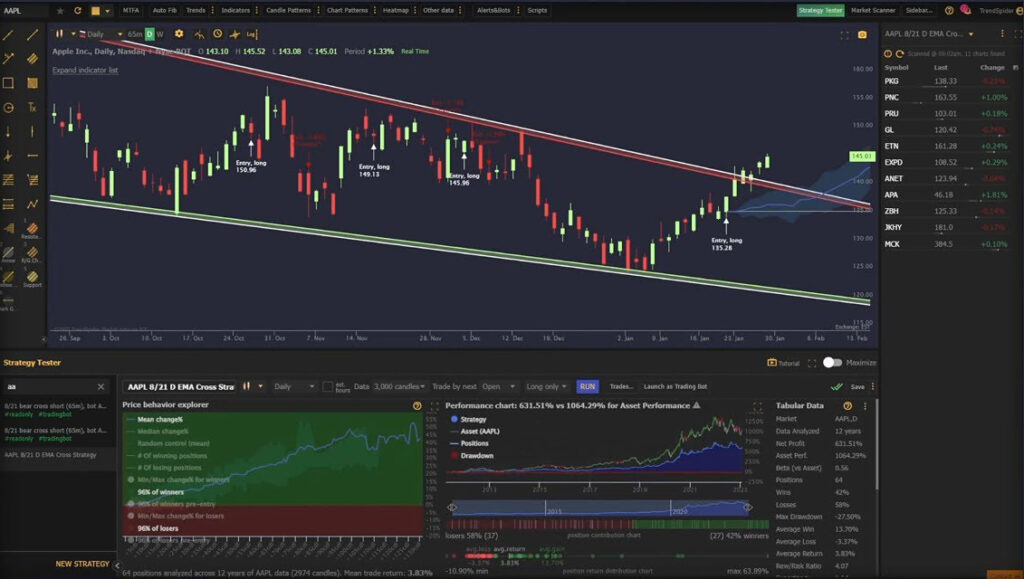When it comes to learning how to make money in the stock market, it’s a journey filled with both triumphs and pitfalls. In the world of stock market trading, it’s a place where dreams can come true, but it can also turn into a nightmare for those who don’t understand the game.
When I share my stock charts and tips on social media, it’s surprising to see how excited people get about stocks that are sky-high and about to nosedive. When I warn them about the risks in those charts, they all jump at me, asking, ‘What’s your problem?’ It makes me feel for those about to get caught in the stock storm.

In this article, we will explore why beginners often lose their money in the stock market, highlight the key differences between novice traders and seasoned experts, and provide insights into how to make money in the stock market with 7 essential trading mindsets.
✏️ Table of Contents
🌐 The Dangers of Following the Crowd
When you step into the stock market as a beginner, it’s easy to get caught up in the excitement of rising stock prices. You see stocks surging to new heights, and you start thinking about when to buy. It’s a common mindset for newcomers, but it’s not how the pros think.
Expert traders, on the other hand, have a different perspective. They focus not on when to buy, but when to sell. They can sense when a stock that’s been soaring is on the verge of a major crash. This ability to read the market’s sentiment is what sets them apart.
❗ The Manipulation Game

One of the harsh realities of the stock market is that some seasoned traders intentionally hype up stocks through various media channels, including social media, knowing that the prices will eventually plummet. They do this to sell their shares at inflated prices, leaving unsuspecting beginners in the dust. It’s a game of manipulation, and beginners need to be cautious.
🌐 The Tale of the Shoeshine Boy
The story of the shoeshine boy is a cautionary tale in the world of stock trading. It serves as a warning that when the market is flooded with talk of guaranteed profits, it’s a sign that a crash may be imminent. The story goes back to 1929 and revolves around a shoeshine boy offering stock tips.
Joseph P. Kennedy, a successful stock investor and future father of U.S. President John F. Kennedy, once had his shoes shined by a young boy on Wall Street.
To his surprise, the boy advised him how to make money in the stock market. This unexpected encounter made Kennedy realize that the market was overheated, and he promptly sold all his stocks.

Not long after, the Great Depression struck in October 1929, causing a massive stock market crash. Kennedy’s foresight and quick actions saved him from financial ruin.
🌐 The Essence of the Shoeshine Boy
But why is the story of the shoeshine boy significant, and what does it teach us about the stock market?
This story captures the essence of market dynamics, as explained by the Dow Theory.
According to this theory, major trends in the market occur in three stages:
1) The Advance Period: Professionals buy at low prices, and stock prices slowly rise.
2) The Following Period: More investors, including those inexperienced in trading, join the market, and the trend becomes unmistakably upward.
3) The Profit-Taking Period: Media coverage intensifies, beginners flood the market, and stock prices soar. However, professionals start selling to lock in their profits, eventually leading to a market crash.

In essence, when beginners and amateurs start proclaiming that stocks will only go up, it’s a clear sign that the market is at its peak. Investing at this stage often results in buying high and incurring significant losses.
🌐 The Modern-Day Shoeshine Boys
Though the original story dates back to 1929, its message remains relevant today. Human nature hasn’t changed, and the same phenomenon still applies to modern times.
You should be cautious when people with no prior interest in stocks suddenly become enthusiastic about theme, specially if they claim to know how to make money in the stock market without much effort. When you hear statements like “You can make money while sleeping,” it’s a signal that the market might be approaching its peak.
In modern times, the shoeshine boy is anyone whose usual activities have little to do with stocks or investments. Their sudden interest often foreshadows a market crash, similar to the bursting of a bubble.
⚡ Recent Examples
1. Cryptocurrency Bubble Burst in 2017
In 2017, the cryptocurrency market experienced a bubble that eventually burst. Bitcoin’s price skyrocketed from around $1,000 to over $19,000 in a matter of months. Many beginners flocked to the market, lured by promises of quick riches.
Media coverage amplified the hype, with claims like “You can make money while sleeping.” However, the bubble burst in 2018, and Bitcoin’s price plummeted.

2. 2021 U.S. Stock Index
More recently, social media and online platforms were flooded with claims that U.S. stocks would continue to rise indefinitely. As a result, novice investors poured into the market, driving stock indices to record highs.
However, in early 2022, the S&P 500, a leading U.S. stock index, fell by over 25% due to global inflation and monetary tightening.

🌐 The Tale of the Shoeshine Boy’s Warning
The story of the shoeshine boy is not based on real events but is a fictional narrative created to illustrate a market phenomenon. While the characters and events within the story are not grounded in reality, the lessons it imparts are very much applicable to the world of stock trading.
The story is a cautionary tale that highlights the risks of jumping into a stock that has already experienced significant gains. It also illuminates the distinctions between novice traders and experienced ones. Though the story originated in the 1920s, its fundamental message continues to hold immense relevance in today’s trading landscape. Furthermore, its lessons can be applied not only to long-term chart analysis but also to the realm of swing trading.
If you find yourself drawn to stocks and investments despite having little prior involvement in the financial world, it’s a red flag to heed. The enthusiasm of individuals who typically don’t engage with the market can be an indicator that the market is overheated and due for a downturn.
❗ The Manipulative Tactics of Joseph P. Kennedy

In this lesson, one more thing we must always be aware of is that, as we talked about earlier, the market can be manipulated by unscrupulous seasoned traders to make us victims of their profit.
Joseph P. Kennedy was a shrewd and, some might say, ethically questionable figure in the world of stock marketing. He employed tactics like recruiting ordinary investors through advertisements and intentionally inflating market prices to push stocks to the brink of a crash, only to sell them off at substantial gains. Kennedy was the puppeteer whispering into the innocent ear of the “shoeshine boy.”
This tale underscores a harsh reality – when someone assures you of a surefire way how to make money in the stock market, they may be keeping the real profit for themselves while leading others down a risky path. It serves as a stark reminder that in the world of stocks and investments, things are not always as they seem.
🌐 How to Make Money in the Stock Market Amidst the Shoeshine Boy Phenomenon
In the ever-evolving world of stock market trading, making money requires not only a sound strategy but also the ability to navigate through the noise and chaos. The story of the shoeshine boy, as discussed earlier, offers valuable insights into recognizing potential market downturns.
Here are some key pieces of advice for traders looking to profit in the stock market, especially when faced with situations reminiscent of the shoeshine boy’s enthusiasm:
1️⃣ Maintain Skepticism:

In the dazzling world of stock trading, skepticism is your shield against the siren call of overhyped stocks. When the crowd is frenzied and optimism skyrockets, remember this age-old wisdom: If it seems too good to be true, it often is. Don’t blindly leap into investments based on others’ enthusiasm, especially when their track record is untested.
2️⃣ Conduct Thorough Research:

Before committing your hard-earned capital, embark on a journey of discovery. Dive deep into a company’s fundamentals, decipher market trends, and survey the economic landscape. This thorough exploration equips you with the knowledge to make well-informed decisions, safeguarding you against unwarranted hype.
3️⃣ Diversify Your Portfolio:

Spreading your investments across different asset classes and industries can help mitigate risk. Diversification allows you to weather market fluctuations and reduce your vulnerability to the impact of a single stock’s decline.
4️⃣ Educate Yourself:

Continuously educate yourself about the stock market. Staying informed about financial news, market trends, and economic indicators is crucial for making informed decisions and managing risks. Knowledge is your greatest asset in navigating the complexities of the stock market.
Consider enrolling in an online trading course like StockOdds to enhance your skills and understanding. StockOdds offers a wide range of educational materials and insights to help you become a more confident and successful trader.
To learn more about StockOdds, take a look at my comprehensive review in this article:
“Unveiling the Best Stock Trading Course: A Comprehensive Review of StockOdds.“
5️⃣ Expert Guidance:

Many traders find value in seeking professional advice, whether from financial advisors or by subscribing to reputable trading signal services. These services serve as invaluable guides, akin to having a seasoned market expert by your side. They provide timely, well-researched recommendations for your trades and are staffed by professionals with years of experience in analyzing market trends. They can be your key to unlocking profitable opportunities in the stock market.
6️⃣ Embrace Automation:

Leverage tools like “TrendSpider” to maintain an objective view of the market. This cutting-edge solution automates technical analysis, eliminating emotional bias from your trading. With advanced charting, backtesting, and custom alerts, it empowers you with data-driven insights to enhance your trading strategy. Discover how “TrendSpider” reduces emotional biases for informed, data-driven decisions.
7️⃣ Practice Discipline:

In the rollercoaster world of stocks, emotional control is paramount in stock market success. Develop a trading plan and stick to it, regardless of market sentiment. Avoid impulsive decisions based on fear or greed, as these emotions can lead to losses.
🍵 Conclusion
In conclusion, understanding how to make money in the stock market is not just about chasing high returns but also about navigating the market’s twists and turns with a strategic mindset. The story of the shoeshine boy reminds us that market sentiment can be misleading, and it’s essential to approach investment opportunities with caution and diligence.
By staying informed, diversifying your portfolio, and considering professional guidance, you can enhance your chances of success. Additionally, tools like “TrendSpider” can provide you with a data-driven, objective view of the market, reducing the impact of emotional trading.
Ultimately, achieving profitability in the stock market requires a combination of knowledge, discipline, and a keen ability to separate genuine opportunities from unwarranted hype. As you embark on your trading journey, keep these principles in mind to maximize your chances of making money in the stock market while avoiding the pitfalls that often trap uninformed or emotional traders.
🌿 Frequently Asked Questions (FAQs)
1. Is stock trading a guaranteed way to make money?
No, stock trading is not a guaranteed way to make money. It carries inherent risks, and losses are possible. It’s essential to approach stock trading with a well-thought-out strategy, research, and discipline to increase your chances of success.
2. Can beginners make money in the stock market?
Yes, beginners can make money in the stock market, but it requires education, practice, and a cautious approach. Learning about stocks, conducting research, and seeking guidance can help beginners navigate the market more effectively.
3. How do I avoid falling for unwarranted hype in the stock market?
To avoid falling for unwarranted hype, maintain skepticism and conduct thorough research before making investment decisions. Consider professional guidance and use data-driven tools to reduce emotional biases.
4. What is the significance of diversifying my investment portfolio?
Diversifying your investment portfolio means spreading your investments across various asset classes and industries. It helps mitigate risk by reducing your exposure to the potential decline of a single stock. Diversification can contribute to more stable and balanced returns.
5. How can I stay informed about the stock market?
Staying informed about the stock market involves regularly checking financial news, market trends, and economic indicators. You can also consider enrolling in online trading courses and subscribing to reputable financial publications to enhance your knowledge.
6. What are trading signal services, and how can they help?
Trading signal services provide timely and well-researched recommendations on buying and selling stocks. They are staffed by experts with experience in analyzing market trends. Subscribing to these services can offer valuable guidance for your trades.
7. How can automation tools like “TrendSpider” benefit my trading strategy?
Automation tools like “TrendSpider” automate technical analysis, removing emotional bias from your trading decisions. They offer advanced charting, backtesting, and custom alerts, providing data-driven insights to enhance your trading strategy.
8. Why is discipline important in stock trading?
Discipline is crucial in stock trading because it helps you stick to your trading plan, regardless of market sentiment. Emotional control prevents impulsive decisions driven by fear or greed, which can lead to losses.
9. Where can I access real-time stock charts?
When it comes to real-time stock charts, look no further than TradingView, a platform that I personally use and highly recommend.
TradingView is more than just a charting tool; it’s a comprehensive online trading platform that offers a rich toolkit for traders. With its user-friendly interface, a wide range of technical indicators, and the ability to customize your charts, it’s considered by many as the best platform for in-depth stock chart analysis.
Whether you’re a novice or an experienced trader, TradingView provides the real-time data and tools you need to make well-informed trading decisions in today’s dynamic market.
👉👉 Connect with Me: Instagram and StockTwits ✌️





